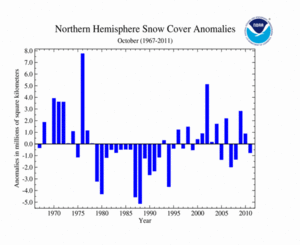NH Snow Cover Extent
October marks the beginning of the cold season for the Northern Hemisphere and storms begin bringing snow to the higher latitudes and elevations. During October 2011, the Northern Hemisphere snow cover extent was 761,000 square km (294,000 square miles) below the long-term average of 17.9 million square km (6.9 million square miles). The monthly value ranks as the 15th smallest October snow cover extent in the 44-year period of record.
Across North America, snow cover extent for October 2011 was below average. The U.S. and Canada both had below average snow cover extent during the month. The North American snow cover extent was 194,000 square km (74,900 square miles) below the long-term average of 8.1 million square km (3.1 million square miles). This is the 18th smallest October snow extent since the satellite record began in 1967. For the continent, below-average snow cover was observed across the U.S. and Canadian Rockies, the Canadian Pacific Ranges, and eastern Hudson Bay. Above-average snow cover was observed along the U.S. northeastern coast, the eastern Canadian prairies, and along the Arctic coast. For more information on the U.S. October 2011 snow events, please visit the U.S. October Snow/Ice Summary page.
Eurasian snow cover extent was also below average for October 2011, with an aeral extent of 9.3 million square km (3.6 million square miles), 568,000 square km (219,000 square miles) below average. This was the 18th smallest October snow extent on record. Above-average snow cover was observed for eastern Russia, northern Kazakhstan, and the Tibetan Plateau, while below-average snow cover was observed over central and western Russia, and the Himalayas.
Data were provided by the Global Snow Laboratory, Rutgers University.
Sea Ice Extent
According to the National Snow and Ice Data Center (NSIDC), the Northern Hemisphere sea ice extent — which is measured from passive microwave instruments onboard NOAA satellites — averaged for October 2011 was 7.10 million square kilometers (2.74 million square miles). The monthly extent was 23.5 percent below the 1979-2000 average and ranked as the second smallest October Northern Hemisphere sea ice extent in the satellite record. The October 2011 Arctic sea ice extent was 333,000 square kilometers (127,000 square miles) larger than the lowest October extent on record in 2007. Northern Hemisphere sea ice extent has declined at a rate of 6.6 percent per decade. The NSIDC stated that by the end of October, ice extent remained below the 1979 to 2000 average in the Beaufort and Chukchi seas and in the Barents and Kara seas. Extent was near average in the East Greenland Sea. By the end of the month, new ice growth closed both the Northwest Passage and the Northern Sea Route. This is the 15th consecutive October and 125th consecutive month with below-average Arctic sea ice extent.
October 2011 Southern Hemisphere sea ice extent was 1.2 percent above the 1979-2000 average. This was the 12th largest (22nd smallest) October Southern Hemisphere sea ice extent on record. Southern Hemisphere October sea ice has increased at an average rate of 0.8 percent per decade.
For further information on the Northern and Southern Hemisphere snow and ice conditions, please visit the NSIDC News page.
 NOAA's National Centers for Environmental Information
NOAA's National Centers for Environmental Information




